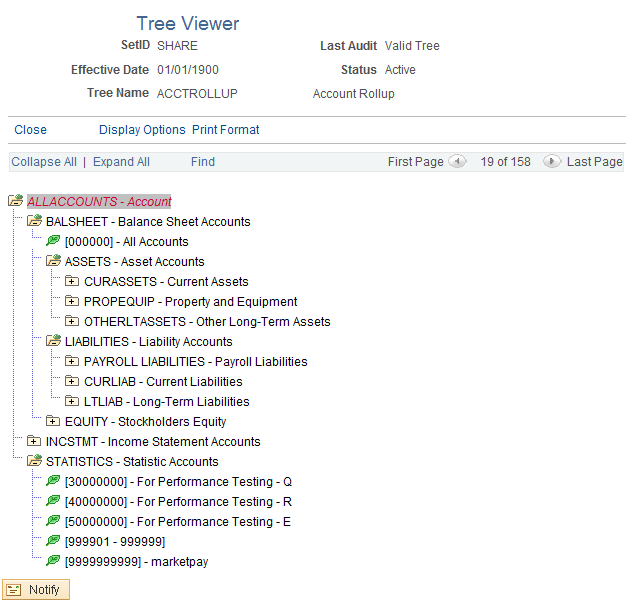Understanding ChartField Summarization with Trees
It is advisable to use trees for organizing and maintaining the ChartFields for completeness as well as for efficiency in reporting. Trees provide an intuitive, visual representation of how detail values in the chart of accounts fit into the big picture or reporting structure. Design tree structures, either detail or summary, from the top down by using PeopleSoft Tree Manager. Next, add ChartField values as leaves to the branches of the tree. In the following example of a balance sheet detail tree, The BALSHEET tree node is a child node of the ALLACCOUNTS tree node, and the (000000) - All Accounts, is a detail value reporting to the BALSHEET tree node. If you click the ASSETS -Asset Accounts, a range of detail asset accounts appears. You can create one or more trees for each ChartField, depending on your reporting needs. Ideally, design your trees with all of your reporting needs in mind so that each tree can be used for the majority of your reports and processes. Create additional trees for a ChartField if the primary tree classifies values differently than is required by a given report.
When new ChartField values are added to control tables, they should be added to the trees; if not, the tree becomes invalid until the missing values are added to the tree. It is good practice to build trees with ranges of detail values wherever possible to avoid having to update the trees with individual new values often. To create financial reports or generate rules for processes such as summary ledgers, allocations, ChartField combination editing, or year end close, specify the appropriate tree and indicate the level, node or branch from which data is to be used.
The following image shows a portion of the ACCTROLLUP tree, which uses the ACCOUNT structure for the ACCOUNT ChartField:
This example illustrates the fields and controls on the Tree Viewer page - example of an Account tree. You can find definitions for the fields and controls later on this page.

You can copy a tree and modify it for various other uses. When you modify a tree within PeopleSoft Tree Manager, the system automatically accesses the updated tree.
See the product documentation for PeopleTools: Tree Manager.
Before you use PeopleSoft Tree Manager to create your trees, do the following:
Define all ChartFields and ChartField values to be used.
Define the organizational structure.
Define ChartField summarization levels.
Define reporting relationships.